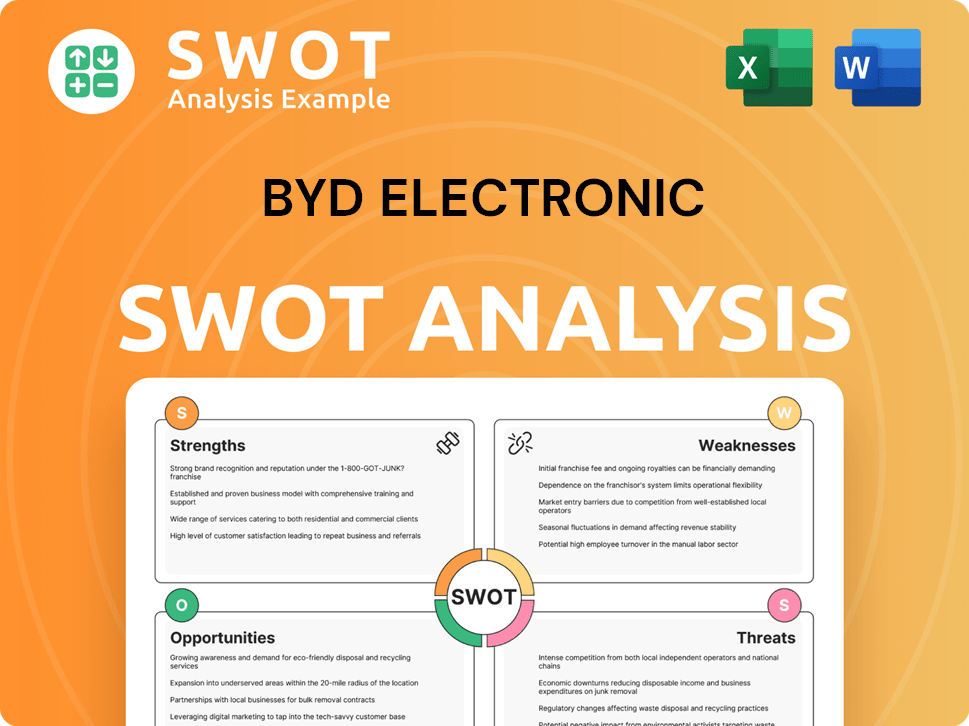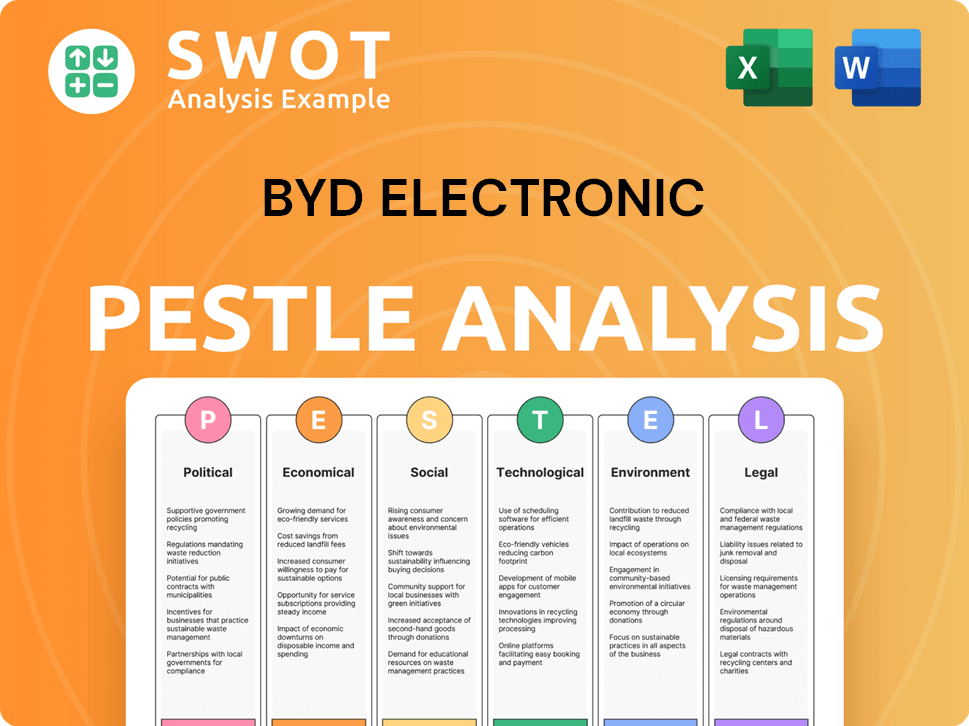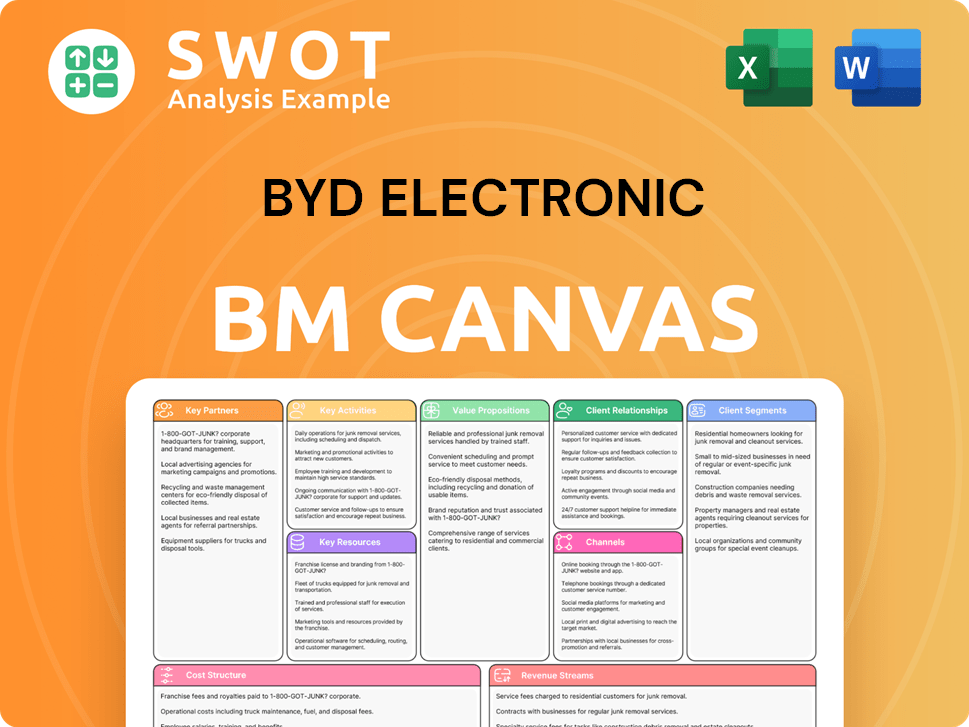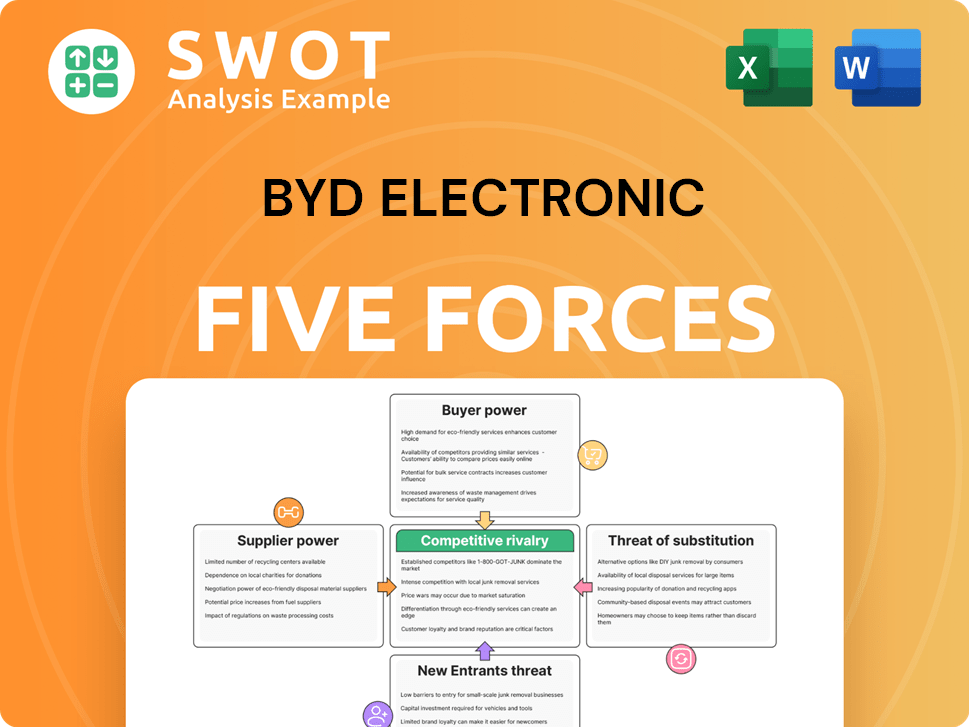BYD Electronic Bundle
How Has BYD Electronic Dominated the EV and Smart Device Markets?
BYD Electronic's journey from a battery manufacturer to a global leader in electric vehicles and smart devices is a compelling story of strategic adaptation. Its groundbreaking shift towards sustainable design and new energy vehicles (NEVs) has reshaped the automotive industry. This analysis dissects the BYD Electronic SWOT Analysis, exploring the sales and marketing strategies that fueled its remarkable rise.

Understanding BYD Electronic's approach to its sales process and marketing campaigns is crucial for investors and strategists alike. This document provides a comprehensive BYD Electronic market analysis, examining its business model and competitive advantage. We'll explore its target market, sales strategy in China and North America, and its future sales and marketing plans, providing actionable insights into this dynamic company.
How Does BYD Electronic Reach Its Customers?
The sales strategy of BYD Electronic primarily centers on a business-to-business (B2B) model, focusing on providing design, R&D, manufacturing, and supply chain management services. This approach involves direct sales teams and strategic partnerships with major smart device brands. These brands include Samsung, Nokia, Huawei, OPPO, and HP, highlighting a focus on the consumer electronics sector. This B2B model is a key component of BYD Electronic's overall market strategy.
For the broader BYD Group, which includes BYD Electronic's contributions to automotive intelligent systems, the sales channels are more diversified. This diversification encompasses both online and offline approaches, particularly for passenger vehicles. The group's strategy aims to expand its international presence, targeting a goal where half of its sales come from outside China by 2030. This expansion is supported by a network of physical retail locations and dealerships globally, as well as online platforms.
Offline sales channels for BYD include a global network of dealerships. As of February 2024, BYD had over 400 dealerships across 70 countries and regions. The company is actively expanding in key markets like Europe, establishing partnerships with leading automotive dealers to build comprehensive sales and customer service networks. These partnerships are crucial for global market penetration and have contributed significantly to BYD's growth and market share, according to a recent Owners & Shareholders of BYD Electronic analysis.
BYD Electronic's primary sales channel is its B2B model, focusing on major smart device brands. This involves direct sales teams and strategic partnerships. The target market includes companies like Samsung, Nokia, Huawei, OPPO, and HP.
BYD has expanded its global presence with over 400 dealerships across 70 countries and regions as of February 2024. The company focuses on strategic partnerships with leading automotive dealers. This expansion supports the company's growth and market share.
BYD is integrating online and offline services, particularly for passenger vehicles. Customers can use online platforms for appointments and inquiries. This omnichannel approach enhances efficiency and customer service.
BYD aims for half of its sales to come from outside China by 2030. Key partnerships and exclusive distribution deals are crucial for global market penetration. The company is expanding its presence in Europe.
BYD Electronic's sales strategy is multifaceted, focusing on B2B relationships and global expansion. The company leverages direct sales teams, strategic partnerships, and a growing international dealership network to reach its target markets. BYD's approach to customer relationship management is crucial for its success.
- B2B Focus: Direct sales to major smart device brands.
- Global Dealerships: Over 400 dealerships worldwide.
- Online Integration: Promoting online service platforms.
- International Growth: Aiming for half of sales outside China by 2030.
BYD Electronic SWOT Analysis
- Complete SWOT Breakdown
- Fully Customizable
- Editable in Excel & Word
- Professional Formatting
- Investor-Ready Format

What Marketing Tactics Does BYD Electronic Use?
The marketing tactics employed by BYD Electronic are comprehensive, with a strong emphasis on digital strategies. These strategies are designed to build brand awareness, generate leads, and ultimately drive sales. The company's approach is data-driven, allowing for continuous optimization of its marketing efforts. A deep dive into the Competitors Landscape of BYD Electronic reveals how these tactics are crucial in a competitive market.
BYD Electronic leverages a variety of digital channels, including content marketing, search engine optimization (SEO), and paid advertising. Social media platforms such as Instagram, Weibo, and WeChat are actively used to engage with consumers and promote products. Furthermore, the company focuses on customer segmentation and personalization to tailor its offerings to different consumer groups.
Traditional media, such as TV, radio, and print, still form part of the marketing mix, though digital channels have taken precedence. Innovations like virtual showroom experiences enhance customer engagement. These tactics are designed to align with BYD's commitment to sustainability, often highlighting green technology and environmental responsibility.
BYD Electronic heavily invests in digital marketing, recognizing its effectiveness in reaching a broad audience. This includes content marketing, SEO, and paid advertising across various platforms. These digital strategies are key components of the BYD Electronic marketing strategy.
Social media platforms like Instagram, Weibo, and WeChat are vital for engaging with consumers. BYD uses these channels to promote products and foster direct interaction. Campaigns often feature hashtags like #BYDHan to increase engagement.
BYD utilizes data analytics to track campaign performance and optimize its strategies. This includes customer segmentation, where different consumer groups are targeted based on various factors. This approach is essential for the BYD Electronic market analysis.
BYD segments its customer base based on geography, demographics, and psychographics. This allows the company to tailor its offerings to specific needs. For example, price-sensitive consumers are targeted with affordable models.
Personalization is a key element, with customizable EV options and personalized insights offered to customers. This approach enhances customer satisfaction and brand loyalty. This is a crucial part of the BYD Electronic sales strategy.
BYD leverages strategic partnerships to enhance brand visibility. Sponsorships, such as the UEFA Euro 2024, are used to bolster digital campaigns and reach a wider audience. Such partnerships are part of the BYD Electronic business model.
BYD Electronic's marketing tactics are multifaceted, focusing on digital channels and data-driven insights. The company's approach includes a blend of traditional and innovative methods to reach its target market. The BYD Electronic competitive advantage is enhanced by these strategies.
- Digital Marketing: Content marketing, SEO, paid advertising, and email marketing are integral. In 2024, digital ad spending in China reached approximately $150 billion, reflecting the importance of digital channels.
- Social Media: Platforms like Weibo and WeChat are used extensively for direct customer engagement. BYD's campaigns often include interactive content and contests.
- Data Analytics: Analytics tools are used to track campaign performance and optimize strategies. Customer segmentation is a key element, with targeting based on geographic, demographic, and psychographic factors.
- Traditional Media: TV, radio, and print are still part of the mix, though digital channels are prioritized.
- Innovation: Virtual showroom experiences provide immersive product exploration.
- Sustainability Focus: Marketing campaigns often highlight green technology and environmental responsibility.
- Strategic Partnerships: Sponsorships and collaborations, such as the UEFA Euro 2024, boost brand visibility.
BYD Electronic PESTLE Analysis
- Covers All 6 PESTLE Categories
- No Research Needed – Save Hours of Work
- Built by Experts, Trusted by Consultants
- Instant Download, Ready to Use
- 100% Editable, Fully Customizable

How Is BYD Electronic Positioned in the Market?
BYD Electronic, a key player within the BYD Group, strategically positions its brand around technological innovation, sustainability, and value. This approach differentiates it from competitors in the dynamic electronics and automotive markets. The core message emphasizes 'making life more enjoyable through technology innovation' and a commitment to a 'green dream,' aligning with the company's vision for a zero-emission energy ecosystem.
The visual identity and overall tone consistently convey a forward-thinking, environmentally conscious, and technologically advanced image. This brand positioning is crucial for attracting a diverse consumer base, especially those increasingly concerned with environmental impact and technological advancements. The company's commitment to sustainability is a key element of its brand identity, resonating with eco-conscious consumers.
The company's brand positioning is also influenced by its vertically integrated supply chain, which allows for cost control and continuous innovation. This is a key element of the BYD Electronic sales strategy and BYD Electronic business model, enhancing its BYD Electronic competitive advantage. This approach allows it to offer advanced products at competitive prices, appealing to a broader consumer base. To understand the company's origins and evolution, a good starting point is Brief History of BYD Electronic.
BYD Electronic emphasizes technological advancements in its products, particularly in electric vehicles and consumer electronics. This focus on innovation is central to its brand identity and marketing efforts. The company invests heavily in research and development to stay ahead of the curve.
Sustainability is a core value, with a commitment to reducing carbon emissions through electric vehicles and renewable energy solutions. This commitment resonates with eco-conscious consumers and supports its long-term goals. BYD aims to achieve net-zero carbon emissions by 2050.
BYD positions itself as offering high-quality products at competitive prices, making advanced technology accessible to a wider audience. This strategy is particularly evident in its electric vehicle offerings, where it competes effectively with established brands. This strategy helps to define its BYD Electronic target market.
While strong in China, BYD is actively working to strengthen its global brand awareness and build emotional connections with customers. This involves tailoring its offerings to local preferences and focusing on customer experience. The company is expanding its sales and marketing efforts in North America and other regions.
BYD's brand positioning is supported by several key differentiators that set it apart from competitors. These elements are critical to its BYD Electronic marketing strategy and overall success.
- Vertically Integrated Supply Chain: This allows for cost control, quality assurance, and continuous innovation, particularly with its proprietary Blade Battery technology.
- Blade Battery Technology: Highlighted for its superior safety, performance, and longevity, providing a competitive edge in the EV market.
- Affordability and Practicality: Offering advanced EVs at competitive prices, appealing to a broader consumer base beyond just luxury buyers.
- Sustainability Focus: Attracting eco-conscious consumers by showcasing its role in reducing carbon emissions through electric vehicles and renewable energy solutions.
BYD Electronic Business Model Canvas
- Complete 9-Block Business Model Canvas
- Effortlessly Communicate Your Business Strategy
- Investor-Ready BMC Format
- 100% Editable and Customizable
- Clear and Structured Layout

What Are BYD Electronic’s Most Notable Campaigns?
The company's sales and marketing strategy is characterized by impactful campaigns designed to enhance brand visibility and drive sales. These campaigns are strategically crafted to resonate with diverse audiences and leverage various platforms, from traditional media to digital channels. Through these efforts, the company aims to build a strong brand presence and solidify its position in the competitive market. This approach is a crucial component of the overall BYD Electronic sales strategy.
Historically, the 'Green Dream' campaign, launched in 2011, highlighted the company's vision for a zero-emission energy ecosystem. More recently, campaigns like 'Dolphin on the Road' have focused on enhancing consumer perceptions. These initiatives demonstrate the company's commitment to environmental solutions and building brand awareness. The company's approach also involves localized campaigns and strategic partnerships to increase market penetration and engagement.
The company's marketing strategy includes leveraging digital platforms and strategic partnerships. For example, the 'Blow up the Badge' campaign, utilized TikTok to connect with younger audiences in the UK and France. Furthermore, the company's official partnership for the UEFA European Football Championship 2024 aims to significantly boost digital campaigns and enhance brand visibility across European markets. These combined efforts form a robust BYD Electronic marketing strategy.
Launched in 2011, this campaign showcased the company's vision for a zero-emission energy ecosystem. It integrated EVs, energy storage, and solar energy products. The campaign underscored the company's commitment to environmental solutions and set the stage for future positioning.
This campaign has been significant in building brand awareness and boosting sales in the competitive EV market. It focused on enhancing consumer perceptions and increasing the visibility of the company's EV offerings. This initiative supports the company's BYD Electronic market analysis efforts by raising consumer interest.
This localized campaign utilized TikTok to connect with younger audiences in the UK and France. The digital campaign aimed to increase brand engagement and tap into new market segments. This approach indicates a strategic use of social media for targeted marketing.
The company's official partnership aims to significantly bolster digital campaigns and enhance brand visibility across various European markets. This sponsorship will increase engagement and brand awareness outside of China. This highlights a strategy to expand global reach.
These campaigns showcase the company's strategy to combine technological showcases with broad-reach sponsorships and targeted digital content to drive growth and establish its brand globally. The company's approach to customer relationship management is centered around building brand loyalty and expanding market reach. For more details, consider exploring the BYD Electronic business model and how it influences market strategies.
The company's campaigns are designed to effectively communicate its brand values and product offerings. This includes leveraging digital marketing and strategic partnerships to engage with diverse audiences. The strategies aim to enhance the company's BYD Electronic competitive advantage in the market.
- Utilizing digital platforms like TikTok to reach younger audiences.
- Sponsoring major events to increase global brand visibility.
- Focusing on environmental solutions to align with consumer values.
- Building brand awareness through targeted marketing efforts.
BYD Electronic Porter's Five Forces Analysis
- Covers All 5 Competitive Forces in Detail
- Structured for Consultants, Students, and Founders
- 100% Editable in Microsoft Word & Excel
- Instant Digital Download – Use Immediately
- Compatible with Mac & PC – Fully Unlocked

Related Blogs
- What are Mission Vision & Core Values of BYD Electronic Company?
- What is Competitive Landscape of BYD Electronic Company?
- What is Growth Strategy and Future Prospects of BYD Electronic Company?
- How Does BYD Electronic Company Work?
- What is Brief History of BYD Electronic Company?
- Who Owns BYD Electronic Company?
- What is Customer Demographics and Target Market of BYD Electronic Company?
Disclaimer
All information, articles, and product details provided on this website are for general informational and educational purposes only. We do not claim any ownership over, nor do we intend to infringe upon, any trademarks, copyrights, logos, brand names, or other intellectual property mentioned or depicted on this site. Such intellectual property remains the property of its respective owners, and any references here are made solely for identification or informational purposes, without implying any affiliation, endorsement, or partnership.
We make no representations or warranties, express or implied, regarding the accuracy, completeness, or suitability of any content or products presented. Nothing on this website should be construed as legal, tax, investment, financial, medical, or other professional advice. In addition, no part of this site—including articles or product references—constitutes a solicitation, recommendation, endorsement, advertisement, or offer to buy or sell any securities, franchises, or other financial instruments, particularly in jurisdictions where such activity would be unlawful.
All content is of a general nature and may not address the specific circumstances of any individual or entity. It is not a substitute for professional advice or services. Any actions you take based on the information provided here are strictly at your own risk. You accept full responsibility for any decisions or outcomes arising from your use of this website and agree to release us from any liability in connection with your use of, or reliance upon, the content or products found herein.